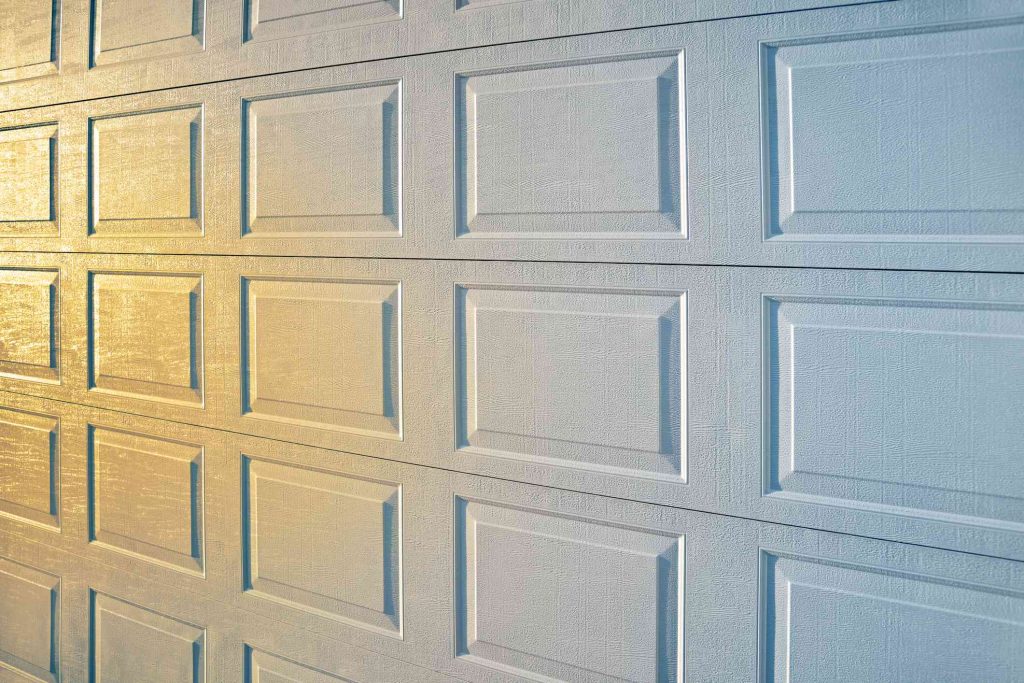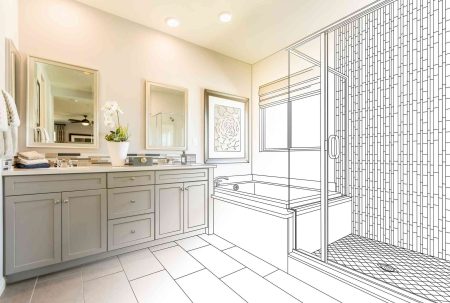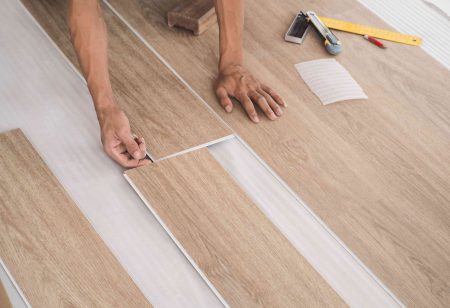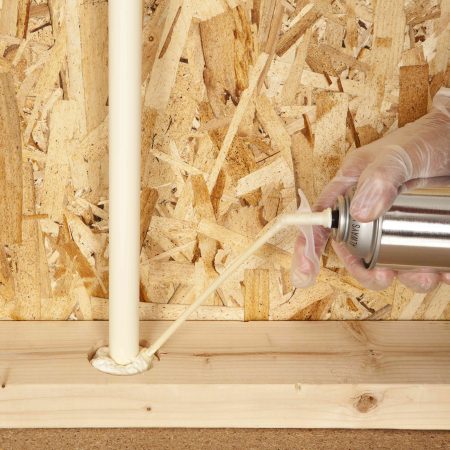Installing a garage door adds security to your home, and it keeps your vehicle and property clean and safe. Though DIY garage door installation is a big project, it’s one that pays off by increasing resale value to your home.
Before You Begin
This guide helps you install a standard single 8-foot wide by 7-foot high non-insulated sectional garage door with extension springs. Installing a garage door with extension springs is easier and safer than installing one that uses a torsion spring as a supplemental lifting mechanism.
When to Install a Garage Door
Because it takes two to three days for most do-it-yourselfers to install a garage door, reserve the project for warm, dry months when it’s less critical that the garage be kept closed up.
If the door from the garage to the house has no lock, install one for security when the garage is left open. Local building code may require that the door be no less than a 1-3/8-inch thick solid entry door. Required in case of fires, this type of solid entry door also provides security when equipped with a lock, though the garage will not be secured.
Safety Considerations
A single-wide steel non-insulated garage door is over 100 pounds. Wider doors, insulated doors, or doors made of other materials might weigh up to 200 pounds or even more. Be careful when lifting the door, especially when the door is not connected to the extension springs.
Never work on extension springs when the garage door is anywhere but in its highest position. When the door is raised, the springs are only minimally tensioned. When the door is down, the springs are taut and can cause injury if they are removed.
What You’ll Need
Equipment / Tools
- Wrench set
- Hammer
- Drill
- Bubble level
- Step ladder
- Safety glasses
Materials
- Garage door, 8-foot wide by 7-foot high (four sections)
- Nails, 3-inch
- Shims
Instructions
-
Remove Garage Door
Remove the existing garage door, if any, along with all components, including metal hangers, guide tracks, cables, pulleys, and the spring.
-
Inspect and Prepare Opening
Make sure that the rough opening is the right size for the door. For a garage door that’s 8-foot wide by 7-foot high, the rough opening should also be 8 feet by 7 feet, not including the stop molding on the frame. Use the level to check that the garage door header is level and that the sides are plumb (vertical).
The framing should be two-by-six lumber and should not be rotted or damaged. Door stop molding should also be in good condition. Stop molding should be in place before installing the garage door, its edges flush with the inside framing.
-
Prepare Bottom Door Section
- Locate the bottom section of this four-sectioned garage door. It will be the section with the rubber weatherstripping along one edge.
- Pull out the bottom section and place it downward (exterior side facing the ground) on cardboard or blankets to avoid scratching it.
- Locate the two metal brackets that will be placed at the bottom (near the weather stripping) on both the left and right sides.
- Attach the metal brackets with the provided screws.
- Locate two of the hinges and attach them to the other long edge of the bottom door section.
-
Install Door Sections
All door sections need to be assembled in a certain order. The sections should be labeled accordingly by the manufacturer. Door sections will be stacked in the rough door opening from bottom to top and temporarily held into place prior to adding the door tracks. This is common practice since an assembled garage door is too heavy and unwieldy to lift into place. Do these steps with an assistant.
- Lay the bottom door section in the door opening. The section should be pressing against the door stop molding.
- If the garage floor/driveway is not level, level out the garage door by placing a shim on one end.
- Tack the bottom section temporarily in place by driving a 3-inch nail into the door frame at an angle on each side.
- With the second section still on the ground, attach hinges to the second section’s long top edge.
- Stack the second section on top of the first section in the rough door opening.
- Tack the second section into place with nails.
- Attach hinges from the top of the first section to the bottom of the second section.
- Continue likewise with the remaining two sections.
-
Add Door Opener Bracket Kit to Top of Door
Steel, aluminum, and fiberglass garage doors need reinforcement at the top door section so that the automatic garage door opener can securely attach to the door.
The bracket kit, which is included with the door, is typically composed of two or three pieces of L-angle steel with pre-drilled holes in them. There will usually be a long steel piece, up to 4 feet long, along the top of the door, with one or two shorter pieces extending downward.
Attach the bracket kit to the top of the top door section. Use the provided screws, lock nuts, washers, and nuts.
-
Attach Garage Door Opener Operator Reinforcement Bracket
If installing an automatic garage door opener, most garage doors have an operator reinforcement bracket that attaches to the top door section.
Attach the operator reinforcement bracket to the garage door with the provided screws, lock nuts, washers, and nuts.
-
Add Rollers
Insert the rollers into the garage door hinges and bottom brackets. The wheels should be facing outward. For a four-section garage door, there will be 10 rollers.
-
Assemble Vertical Track
Assemble the two sections of the vertical track on the ground.
-
Install Vertical Tracks
Install the vertical tracks around the roller wheels. Raised 1/2-inch off of the garage floor, the vertical tracks attach to the garage door frame by means of L-brackets. The vertical track, attached to the L-brackets, wraps over the roller wheels, keeping them in line.
- With the claw end of the hammer, remove the nails on one side of the garage door frame.
- Vertical tracks should be attached to the garage door frame with lag screws. Attach the track on one side only.
- Remove nails from the other side of the door.
- Attach the second vertical track.
-
Attach Horizontal Tracks
Two horizontal garage door tracks carry the garage door up into the open position. Each track has 90-degree metal curves at one end.
With the wrench set, attach an angle bracket to the back of each horizontal track (near the curve). The angle bracket will attach the horizontal track to the vertical track.
-
Support Ends of Horizontal Tracks
The back end of the long horizontal tracks will temporarily be hanging free. Support them by placing step ladders underneath or by hanging them from the ceiling with wires or string.
Lay the bubble level on top of each horizontal track to level them out.
-
Attach Rear Track Hangers to Garage Ceiling
The rear track hanger package usually consists of two or three angled steel brackets (per horizontal track) that attach from the end of the horizontal track to the ceiling.
Make sure that the rear track hanger is positioned so that its bracing prevents side to side movement.
-
Install Springs: Pulleys and Safety Cable
Install the extension springs, starting with one side:
- Attach a pulley (also called a sheave) wheel to the end of the spring. You may need to first assemble the pulley.
- Attach a second pulley wheel to the horizontal track, near the curved section. The pulley wheel should be facing inward.
- Add an eye bolt to the rear track hanger. Position the hook so it is facing the garage door.
- Attach the free end of the extension spring to the eye bolt’s hook, with the pulley end facing the garage door.
- Pass the safety containment cable through the extension spring.
- Attach one end of the safety cable to the hook of the eye bolt.
- Pass the safety cable through the pulley wheel at the end of the extension spring.
-
Install Springs: Lifting Cable
- Draw the safety cable taut to the other end of the horizontal track. Attach it to the top of the vertical track.
- Feed the looped end of the door lifting cable through the pulley at the end of the extension spring.
- Continue to run the lifting cable toward the garage door, feeding it over the stationary pulley wheel.
- Continue to run the cable downward, alongside the garage door.
- Attach the end of the lifting cable to a peg at the bottom of the door track.
- With an assistant raise the door to the halfway point.
- Attach the other end of the lifting cable to the attachment point on the door.
- Repeat for the other side.
-
Test Door
If the vertical tracks are positioned correctly, tighten down the lag screws. Also, tighten the slide bolts on the roller wheels.
Raise and lower the door by hand to check for balance. Position the back of the extension spring higher up on the rear track hanger if the garage door is heavy and doesn’t lift easily.
-
Install Pull Rope
Tie the pull rope to the bottom section of the garage door.
-
Install Lift Handle
On the exterior side of the garage door, install the lift handle.
-
Install Lock
Add the internal slide lock to the garage door by screwing it to the garage wall. The lock should be positioned at a level so that the slide bolt will slide into the open receiving end on the garage door.
When to Call a Professional
Though installing a garage door can be a DIY project, it’s only for experienced DIYers able to devote enough time to safely remove the old garage door and install the new door. Otherwise, call a garage door installation company to do the work.
If the previous garage door has a torsion spring, have a garage door technician remove the spring for you.
Read the full article here














